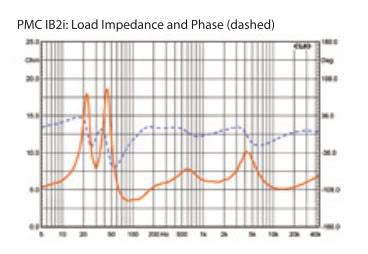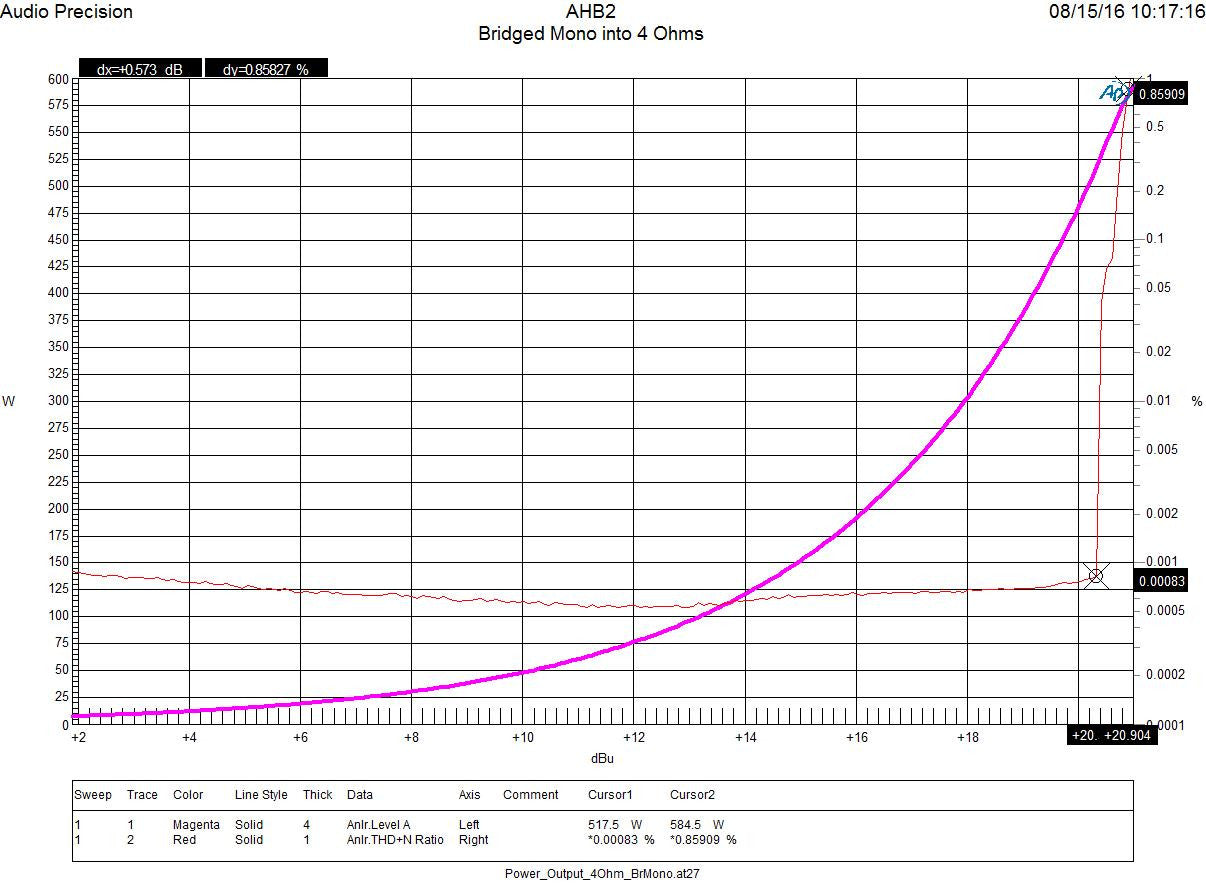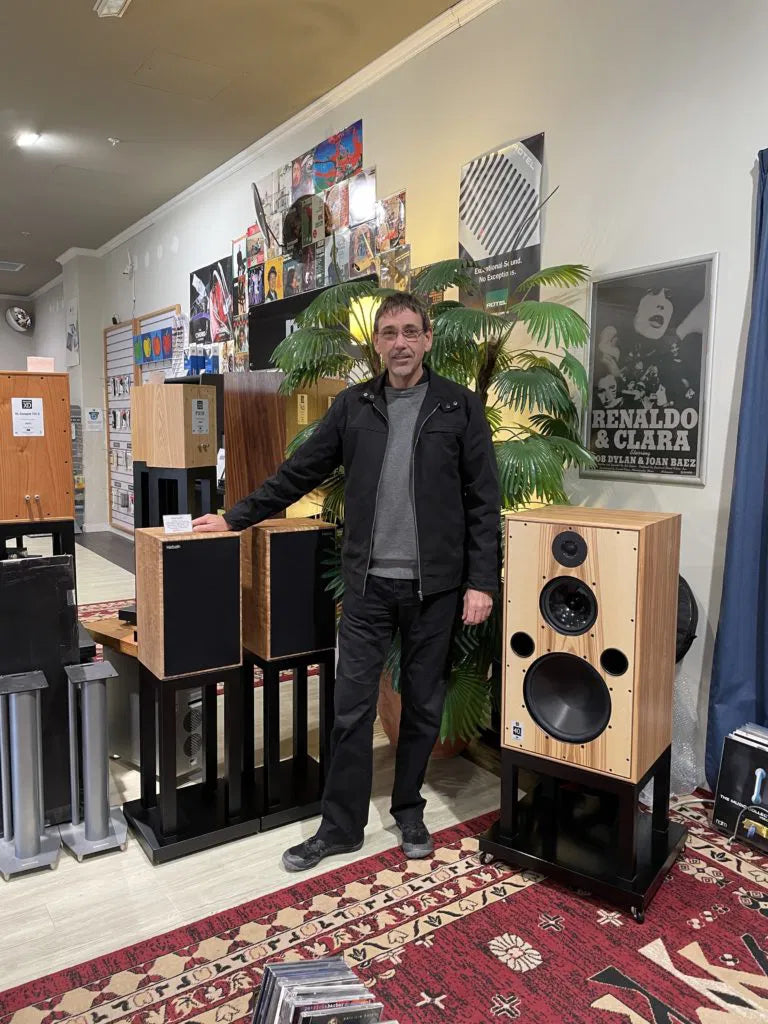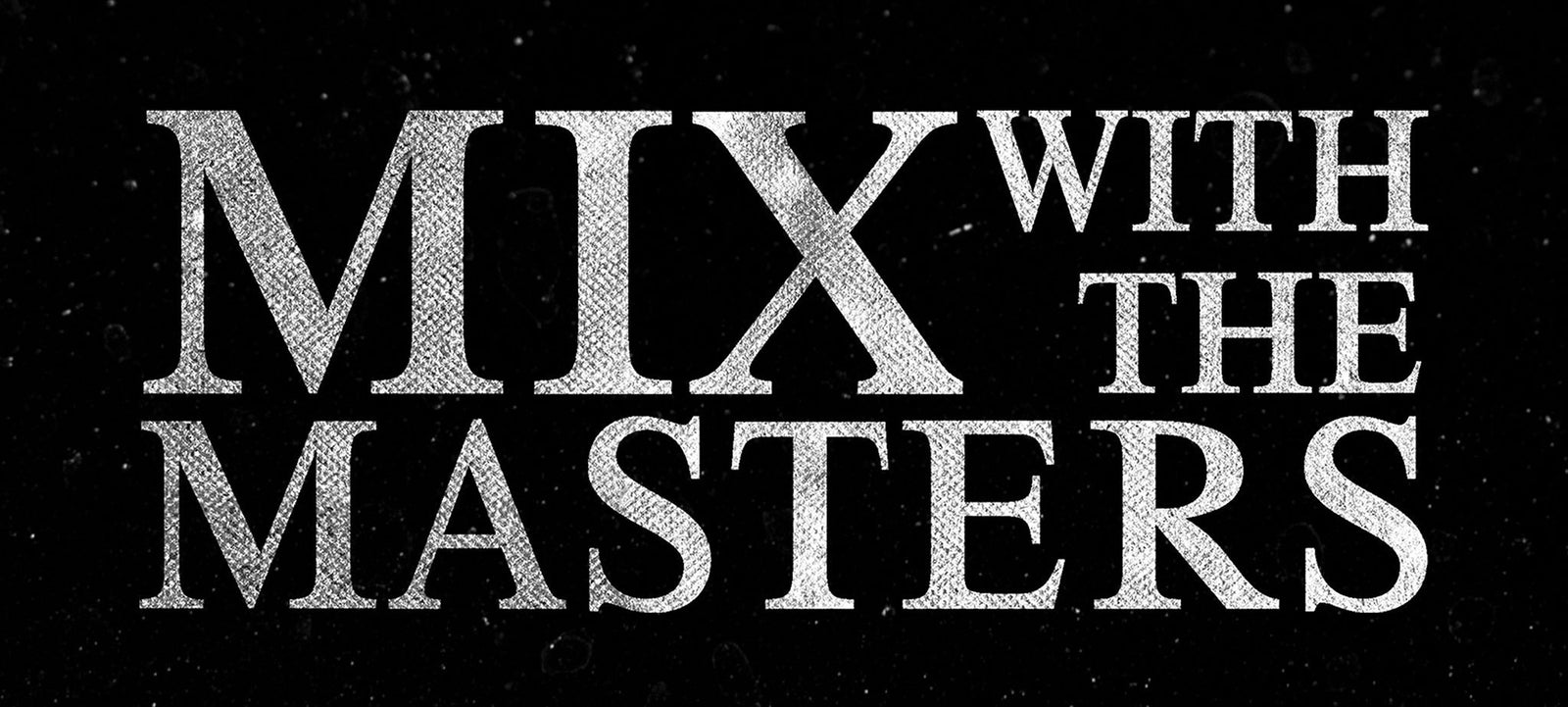Buy one component and save 10% on up to 2 cables. Buy 2 components and get 4 free cables. Free shipping on USA orders over $700. We are closed 12/25 and 12/26.
Buy one component and save 10% on up to 2 cables. Buy 2 components and get 4 free cables. Free shipping on USA orders over $700. We are closed 12/25 and 12/26.
AHB2 - Driving PMC IB2S Studio Monitors
by John Siau October 24, 2016

Benchmark booth at the 141st AES conference where we demonstrated two Benchmark AHB2 monoblock power amplifiers driving a pair of 4-Ohm PMC IB2S studio monitors.
In bridged mono, the AHB2 can deliver over 518 watts into each of these 4-Ohm speakers. This is a perfect match to PMC's 500 watt recommendation. The AHB2 easily provides the power, the output current, and the damping required by these low-impedance speakers. The impedance and phase curves are similar to the older IB2i model (shown in the graph below).

AHB2 THD+N and Power into 4-Ohms, Bridged Mono
518 Watts of Absolutely Clean Power (0.00083% THD+N at 518 W)!
The following plot from an Audio Precision audio analyzer shows the output of the AHB2 driving a 4-ohm load in the bridged mono (single channel) mode. The magenta-colored heavy line shows the power output in watts (W), which can be read off the left-hand vertical axis. The narrower red line shows the total harmonic distortion plus noise (THD+N), which can be read in percent from the right vertical axis. The horizontal axis is the input level to the amplifier. The input level is swept over a 20 dB range which is equivalent to a 100:1 power range (producing a 6 W to 600 W output power sweep from the AHB2).

Note that the output of the AHB2 reaches 518 watts (W) before the THD+N begins rising. The THD+N is only 0.00083% at 518 W! This amazing achievement is made possible by the unique feed-forward error correction system in the AHB2.
If we convert percent to dB, we find that the THD+N of the amplifier is 102 dB below the output level. In most cases, this means that the THD+N will be lower than the threshold of hearing. In other words, the THD+N produced by the AHB2 will be absolutely inaudible.
The plot above demonstrates the high level of clean power that is available from the AHB2 when driving 4-ohms in bridged mono mode. At the upper right-hand corner of the plot we can see that the AHB2 delivers about 590 W before reaching 1% THD+N. If THD+N exceeds 2%, the protection circuits in the AHB2 will activate to protect the tweeters (an important consideration with monitors as expensive as the IB2S).
Maximum Sound Pressure Level
The PCM IB2S monitors have a power sensitivity of 89 dB, 1 W @ 1 m. At 4 ohms, this is equivalent to a voltage sensitivity of 92 dB, 2.83 V @ 1 m (add 3 dB for 4-ohm speakers when doing this conversion). From the voltage sensitivity, we can calculate the maximum sound pressure level when the monitors are driven from AHB2 amplifiers running in mono mode.
With a 4-Ohm load, the AHB2 monoblocks will deliver 518 Watts. The maximum unclipped output voltage is 45.5 Vrms (64.4 V peak). This is 24.1 dB higher than 2.83 Vrms (20*log(45.5/2.83)=24.1 dB). If we add 24.1 dB to the voltage sensitivity of 92 dB we can calculate that the maximum sound pressure level should be about 116 dB at 1 meter from each monitor. This calculation ignores the slight losses that would be produced by power compression due to voice coil heating. Given the size of the voice coils in the IB2S drivers, power compression should be minimal in this example.
At 116 dB SPL, this amplifier/monitor combination will have no trouble filling a good sized control room. The IB2SE hifi version has identical performance and should be very capable in just about any home environment.
Amplifier Noise is Well Below Audibility - A Quick Estimation
In bridged mono the AHB2 has a 135 dB A-weighted signal to noise ratio. This means that the output noise will be about 135 dB lower than the maximum sound pressure level produced by the monitors. If we subtract the SNR from the peak SPL determined above, we can calculate that the amplifier noise will be reproduced at a level that is 19 dB below the threshold of normal hearing (116-135=-19 dB SPL).
Amplifier Distortion is Below the Threshold of Hearing
Given this system's 116 dB maximum sound pressure level, and the -102 dB THD+N, we can calculate that the THD+N will only reach 14 dB SPL while the speakers are delivering 116 dB SPL. At output levels below 102 dB SPL, the amplifier THD+N will be less than 0 dB SPL at a 1 M distance from the speaker. This implies that the amplifier THD+N will be completely inaudible.
Noise Verification - Use Your Ears
In our test setup we confirmed that the AHB2 - IB2S combination is dead quiet at a point-blank distance. The industry-leading 135 dB SNR of the AHB2 really pays off when driving medium and high-sensitivity loudspeakers. With a 135 dB SNR, the AHB2 is 17 to 30 dB quieter than the competition!
If you do the math, it is easy to see that competing amplifiers will produce audible noise when driving 92 dB speakers such as the IB2S. Eliminating low-level hiss and buzz from the monitor chain can help resolve low-level details in the mix. For best results, the studio monitor chain should be dead quiet.
Accurate Method of Calculating Noise
If the amplifier output noise is specified, we can use this to make a more accurate calculation noise produced by the amplifier/speaker combination.
The A-weighted output noise of the AHB2 is 9.8 uV rms when running in mono mode. This is -109 dB relative to 2.83 V rms (20*Log(0.0000098/2.83). Add -109 dB to the voltage sensitivity of your loudspeakers, and you can accurately calculate the acoustic noise produced by the amplifier/speaker system at 1 m. This method is slightly more accurate than subtracting the SNR from the maximum output level because it is not affected by the speaker impedance.
If we rerun the calculations for the IB2S, using this improved method, we will find that the amplifier noise is actually reproduced at - 17 dB SPL (92 dB - 109 dB = - 17 dB). The 2 dB difference is due to the fact that 4-ohm bridged mono loading on the amplifier reduces the clip point of the amplifier by about 1.9 dB relative to 8-Ohm bridged mono loading. The SNR is measured with an 8-Ohm load. The noise does not change with loading, but the maximum unclipped output level changes by 1.9 dB.
This 1.9-dB reduction is very small and it demonstrates the value of the regulated power supplies in the AHB2. In contrast, conventional power amplifiers traditionally have unregulated power supplies. The output of most amplifiers would be reduced by much more than 1.9 dB when driving 4 Ohms in a bridged mono configuration.
Clarity and Accuracy
I am very impressed with the clarity and accuracy of these outstanding professional monitors. The Benchmark AHB2 and PMC IB2S are an absolutely killer combination! This is one of the lowest distortion amplifier-monitor combinations available.

Driver Placement - Cutaway Frame on MF Driver
Notice the cutaway frame on the midrange driver. The close proximity of the HF and MF drivers helps to keep the imaging tight and well defined. This configuration provides excellent imaging at a much closer listening distance than the large cabinet size would suggest. The vertical alignment of the drivers is also an important contributor to the tight imaging provided by these monitors. This combination of vertical alignment and close driver spacing gives these monitors the ability to image well in nearfield to midfield applications.
Center mixed cymbals, brushes and bells are accurately placed in the phantom center image without a trace of high frequencies locating to the drivers themselves. This is an indication that the phase and amplitude responses of the HF drivers were very well-matched between the left and right monitors.
Bass Extension
The 25 Hz bass extension is impressive when playing tracks with deep bass. This is especially true when the monitors are driven by a Benchmark DAC3 to AHB2 signal chain. The DAC3 and AHB2 both have a frequency response that extends down to 0.1 Hz. This 0.1 Hz extension keeps the bass clean while eliminating low-frequency group delays that would cause the bass to arrive late.
Strategic Choice of Crossover Frequencies
The 380 Hz and 3.8 kHz crossover frequencies of the IB2S are largely outside of the vocal range. This means that most of the male and female vocal range is delivered by the midrange driver. This strategic choice of crossover frequencies keeps the vocals exceptionally clean, natural, and well focused.
Caution - Keep an Eye on the SPL
One word of caution: This combination is so clean that you will need to keep an eye on the sound pressure level. The combined AHB2 - IB2S system effortlessly reaches high sound pressure levels and, because of the low THD+N, the system is much louder than is sounds! Keep an SPL meter nearby until you get accustomed to the clarity of this system. We found that the difference in clarity between this system and a typical pair of powered monitors is stunning!
The Test System
Our test system included a Benchmark DAC2 HGC driving two AHB2 power amplifiers. Each AHB2 was running as a monoblock. The combined DAC2 HGC - AHB2 - IB2s signal chain is dead quiet.
The AHB2 amplifiers have a mono switch and a dedicated NL4/NL2 SpeakON output to support the mono mode of operation. On each amplifier, this mono output was connected to a PMC IB2S using Benchmark Studio&Stage™ NL2 SpeakON to locking banana cables. These cables use a star-quad construction to minimize magnetic emissions and losses.
The IB2S monitors have internal passive crossovers and buss bars that strap the inputs so that all three divers can be run from a single amplifier. This is the configuration that we recommend when driving them with the Benchmark AHB2. Locking banana plugs work well with the binding posts on the IB2S.
The PMC IB2S is also available in the IB2SE hi-fi version. Both have identical performance but the IB2SE is available in finishes that will blend into a home environment. The hifi version also features a more attractive stand.
PMC IB2SE - Passive Hi-Fi Loudspeaker

PMC IB2S - Passive Studio Monitor

Also in Reviews
HPA4 Review - AP Mastering
by Benchmark Media Systems September 26, 2025
"This is the best headphone amplifier that I have ever tested. In every conceivable metric, absolutely perfect."
"If you've got the money and you want something that is an engineering masterpiece, this is such a thing."
- AP Mastering

Benchmark System Review - Ricky Dasler, Living Sound, New Zealand
by Benchmark Media Systems July 22, 2025
"With over 40 years as an audiophile and more than half those years as a hi-fi retailer, I feel I’ve finally put together a stereo that ticks all my sonic boxes. Those being in order of priority, dynamics, scale, tonal accuracy, fatigue free resolution and soundstage."
"For the last 25 years I’ve been fortunate to have a dedicated listening room. I use acoustic treatments from Real Traps, Vicoustic and Primeacoustic."
"My Benchmark components consist of the DAC3 B (connected to a Naim NDS streamer), LA4 line amplifier and two AHB2 power amplifiers run in bridged mono mode. All cables are Benchmark too."
"The Benchmark gear in my system has brought what I have wanted in my list of sonic priorities as listed above and then some. They have delivered way beyond what I thought could be possible in my system in my room."
"I’m delighted and stunned daily as my vast music collection comes to life on a whole new level."
- Ricky Dasler, Living Sound, Nelson New Zealand.

Benchmark Converters at Abbey Road - Geoff Pesche
by Benchmark Media Systems June 02, 2025
"What are the Latest Advancements in Mastering?"
"Geoff Pesche weighs in on how the mastering team at Abbey Road Studios achieve first-class results." - Mix with the Masters
"The biggest sonic improvement in mastering in the last 5 or 6 years is D/A and A/D converters and that's very very important - what you have at the front and the back of the chain."
"We use fairly new Benchmark converters front and back."
"Abbey Road like a uniformity between the rooms so all of the rooms have the same A/D and D/A conversion."
- Geoff Pesche, Mastering Engineer, Abbey Road Studios



